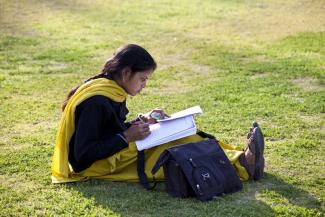Gender relations
U-shaped curve

It is an autumn morning in New Delhi. Young women in the age group 18 to 35 are leaving a hostel. Some are going to their nearby colleges, while others are hurrying to the metro station or trying to halt a three-wheeler, hoping to get to their offices in time. Only young women who are pursuing career ambitions live in this hostel. There are many of its kind in India’s metropolitan cities. That young women leave their fathers’ homes for a different reason than marriage is a new, but wide-spread phenomenon.
Yashika is one of the hostel residents in Delhi. Her mother is a housewife, and her father is a businessman in Hanumangarh, a small district in the neighbouring state of Rajasthan. Yashika says she wanted to study art and did not see any opportunities in Hanumangarh. She managed to convince her parents to let her attend the Art College in Delhi. She does not know what she will do after finishing college, but she sees two options: “I will try to get a scholarship to pursue higher education abroad, or I’ll work for some advertising firm in Mumbai.”
Shailesh is another young woman who has come to the city from a rural area. She is now a senior researcher at the India Meteorological Department, a government agency. “I am currently working on a satellite meteorology project, INSAT-3D,” she says. She plans to complete her PhD in this context. Afterwards, she too would like to leave India. She hopes to be employed by the Japan Agency for Marine-Earth Science and Technology.
Yashika and Shailesh are young urban women with great professional aspirations. The big question is whether their dreams will come true. In some sectors, the picture actually looks rosy. Today, almost 12 % of India’s 5,100 pilots are women, versus three percent worldwide. Moreover, women head the top public and private banks in India. In the disciplines of science, technology, engineering and mathematics (STEM), Indian tech firms tend to employ a greater share of women than those in the USA.
These facts are encouraging, but they do not show the whole picture. According to the International Labour Organization (ILO), India has one of the lowest female labour-force participation rates in the world. Among South Asian countries, it is in the sixth position among eight countries, just above Pakistan and Afghanistan. This means that the ambitions of many young women are obviously stunted. Indeed, the unemployment rate is highest for urban women with graduate degrees and above.
The Kelly Global Workforce Index highlights that Indian women are likely to quit jobs at mid-career level due to the “double burden syndrome”. It results from a culture where both men and women feel the family and household duties are primarily the woman’s responsibility. Mansi is 30 years old and lives in Kolkata. She used to be a senior executive in an IT firm, but quit when her baby was born. Today, many professional couples only have one child, but it is still common for the mother to stop working.
Today, the vast majority of young Indians, whether male of female, want to work and aspire to upward mobility. By 2020, the median individual will be 29 years old and quite likely live in a city. Today, about one third of the urban population is under 35. Economies around the world are currently slowing down, but international economists reckon that India should perform comparatively well. In recent years, annual growth amounted to about seven percent.
One would assume that growth means that more people, including women, work. In the years 2004 to 2010, however, Indian women’s labour-force participation declined from 33.3 % to 26.5 % in rural areas and from 17.8 % to 14.6 % in urban areas. The ILO attributes these trend to increasing enrolment in education on the one hand and higher incomes of men on the other. At the same time, there is a lack of employment opportunities for people with higher levels of skills and qualifications. Though it affects both genders, women tend to struggle more to find jobs and are less vocal about it.
Educated urban people want to work in the formal sector. According to official data, the unemployment rate for women aged 15 to 59 is almost 16%. The comparative figure for men is only nine percent. Obviously, women find it harder to find adequate opportunities. Mercer International, a consultancy, has assessed the situation and found that young women currently account for 40 % of formal-sector recruits, while women only make up 20 % of the mid-management level and their share drops to 10 % among the top leaders.
On the upside, girls enrolment in schools has improved dramatically in the past few decades. The gender gaps in primary and secondary schools have been closed thanks to government policies. The number of children who do not go to school has been reduced by more than 90 %. However, many teenage girls still drop out of secondary schools. According to the Indian National Sample Survey Office (NSSO), the reasons are that they are expected to do domestic chores. Moreover, the marriage age is still quite low, both in rural and urban areas. At the same time, India still has 265 million illiterate adults, and more than two thirds of them are women.
Sirisha C. Naidu is an economics professor at Wright State University in the USA. She says: “The most common understanding of women’s labour-force participation rate is that it is a ‘U-shaped’ curve – high for countries with very low or very high levels of development, and low for countries at middling levels of development.”
Scant rural opportunities
For countries like India, which are beginning to achieve moderate levels of development and hoping to accelerate development by making the transition from an agrarian to an industrial economy, the increase in men’s non-farm jobs boosts household incomes, so the pressure on women to do meagrely paid work is reduced. In the past, men and women alike did farm work, but agriculture is becoming mechanised, so it is keeping fewer people busy
Nonetheless, most women do not want to stay at home. They would prefer to earn money. What is lacking, however, are suitable employment opportunities. This applies to well educated as well as uneducated women.
Some village women move to the cities to look for work. They become household helpers, cleaners, street vendors and salespersons. These jobs tend to be informal and do not offer the security of wage employment.The majority of rural women, however, stays in the villages because moving to the cities is not considered safe. Where they live, there are no suitable jobs for them.
Gender stereotypes matter very much. Archana Pandey works for a non-governmental organisation that wants to train young women for jobs in Uttar Pradesh, one of India’s least developed states. “We have witnessed men refusing to allow their daughters, wives and daughters-in-law to leave the village for training and subsequent job placements,” she says.
India has to increase women’s participation in the labour force. The McKinsey Global Institute, another consultancy, reckons that India can increase its 2025 gross domestic product (GDP) by 16 % to 60 % by enabling women to participate in the economy on par with men. The challenges are huge, however. It is not enough to make streets and transportation safer for women – a male-dominated society must change its mindset.
Roli Mahajan is a journalist based in New Delhi. roli.mahajan@gmail.com













